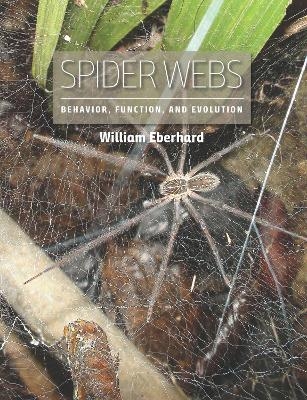
Spider Webs
University of Chicago Press (Verlag)
978-0-226-53460-2 (ISBN)
Stemming from the author's more than five decades observing spider webs, this book will be the definitive reference for years to come.
William Eberhard is an emeritus scientist at the Smithsonian Tropical Research Institute in Panama and emeritus professor at the Universidad de Costa Rica.
Chapter 1. Introduction
1.1 Introduction
1.2 A foreign world: life tied to silk lines
1.3 A brief history of spider web studies
1.4 Emphasis on behavior
1.5 The scope of this book and tactics in presentation
1.6 Evolutionary history and phylogeny
1.7 Terminology and other procedural matters
1.8 Acknowledgments
Chapter 2. The “hardware” of web-building spiders: morphology, silk, and behavior
2.1. Introduction
2.2 Silk glands and silk
2.3 Spinnerets as high-precision instruments
2.4 Leg morphology and behavior: grasping lines precisely and securely
2.5 Cutting lines and recycling silk
2.6 How spiders avoid adhering to their own webs: a mystery partly solved
2.7 Central nervous system basis for web construction
2.8 Summary
Chapter 3. Functions of orb web designs
3.1 Introduction
3.2 Correcting common misconceptions about orb webs
3.3 How orbs function
3.4 Summary
Chapter 4. Putting pieces together: tradeoffs and remaining puzzles
4.1 Introduction
4.2 “Optimal” orb designs: tradeoffs between functions are difficult to measure
4.3 “Multiple trap” design: a new way to view orb webs
4.4 Tensions and stresses
4.5 Relative numbers of radii and sticky spiral loops
4.6 Testing visibility and stopping functions: the extreme case of trunk orbs
4.7 Correlations between spider size and orb design?
4.8 Spider positions, attack behavior, and up-down asymmetries in orbs
4.9 Remaining puzzles
4.10 Non-orb webs
4.11 Evolutionary responses by insects? A neglected aspect of prey capture
4.12 Summary (including part of chapter 3)
Chapter 5. The building behavior of non-orb weavers 5.1 Introduction
5.2 Order of lines and other higher-level patterns5.3 Lower-level patterns: leg movements and manipulation of lines5.4 Stereotyped behavior in non-orb construction5.5 Adjustments to substrate-imposed constraints
5.6 Managing swaths of fine lines
5.7 SummaryBox 5.1 The funnel web diplurid Linothele macrothelifera
Chapter 6. The building behavior of orb-weavers
6.1 Introduction
6.2 Simplifications for smoother reading
6.3 Behavior of two araneids
6.4 Senility in orb construction: a new frontier?
6.5 Detailed movements
6.6 General patterns
6.7 Summary
Chapter 7. Cues directing web construction behavior
7.1 Introduction
7.2 Classifying the cues
7.3 Cues for sticky spiral construction
7.4 Temporary spiral
7.5 Hub
7.6 Stabilimentum construction
7.7 Radii, frames, and anchor lines
7.8 Early radii, and frames and anchor lines: determining web size, shape, and design
7.9 To build or not to build: triggering orb construction and destruction
7.10 Cues that trigger transitions between stages of orb construction
7.11 Other stimuli that spiders can sense but that are not (yet) known to guide orb construction
7.12 Hints of abilities: follow circular paths and sense radius lengths
7.13 Effects of psychotropic drugs on orb construction
7.14 Coordinating different adjustments to different cues
7.15 The (limited) role of simulations in understanding orb construction behavior
7.16 A missing link: translating cues into attachment sites
7.17 Summarizing the behavioral challenges met by orb weavers
7.18 Independence (?) of the spider’s responses
7.19 Changes in responses to cues: learning and maturation
7.20 Cues guiding the construction of non-orbs
7.21 Summary Chapter 8. Web ecology and website selection
8.1 Introduction: what is and is not included
8.2 Webs and ecological foraging theories
8.3 What is enough? “Fast lane” and “slow lane” spiders
8.4 Processes that produce habitat biases
8.5 A general correlation between website selectivity and web design flexibility?
8.6 Website tenacity, web durability, and recycling
8.7 Web durability
8.8 Limited by websites? Possible competition for prey and websites
8.9 Problems in attempts to study cues that guide website choices
8.10 Time of day: day webs vs. night webs
8.11 Summary
Chapter 9. Evolutionary patterns: an ancient success that produced high diversity and rampant convergence
9.1 Introduction
9.2 Patterns in the diversity of webs
9.3 Consequences of the failure of the prey specialist hypothesis for understanding diversity and convergence
9.4 What is a sheet web? Problems inherited from previous imprecision
9.5 Mygalomorphs: similar patterns of diversity and rampant convergence in a different world
9.6 Diversity of relations with insects
9.7 Lack of miniaturization effects
9.8 Paths not followed: alternative web forms in other animals
9.9 Summary and a new synthesis
Box 9.1 The most spectacular convergence of all: Fecenia
Box 9.2 The most spectacular divergence of all: Theridiidae
Box 9.3 Sand castles: extreme modifications of Seothyra henscheli webs to shifting sand
Box 9.4 Relation between web design and silk properties: stiff silk in Uroctea durandi
Chapter 10. Ontogeny, modularity, and the evolution of web building
10.1 Introduction
10.2 Web ontogeny and evolution
10.3 Early web evolution
10.4 The behavior patterns used to build early webs
10.5 Evolution of later non-orb webs
10.6 Inconsistent evolutionary trends in non-orb webs
10.7 Diversity in non-orbs that results from behavioral stability
10.8 The (probably) monophyletic origin of orb webs
10.9 Evolutionary changes in orb designs
10.10 “Post-orb” web evolution in Orbiculariae
10.11 Coevolution between attack behavior and web design (and its lack)
10.12 What didn’t happen, possible synapomorphies, and further puzzles
10.13 Modularity and adaptive flexibility
10.14 Modules and evolutionary transitions in web-building behavior
10.15 Summary
References
Index
| Erscheinungsdatum | 26.01.2021 |
|---|---|
| Sprache | englisch |
| Maße | 216 x 279 mm |
| Themenwelt | Naturwissenschaften ► Biologie ► Evolution |
| Naturwissenschaften ► Biologie ► Zoologie | |
| ISBN-10 | 0-226-53460-X / 022653460X |
| ISBN-13 | 978-0-226-53460-2 / 9780226534602 |
| Zustand | Neuware |
| Haben Sie eine Frage zum Produkt? |
aus dem Bereich


